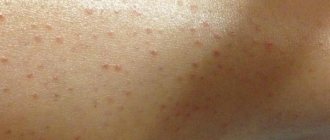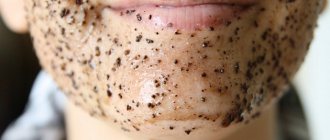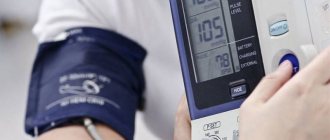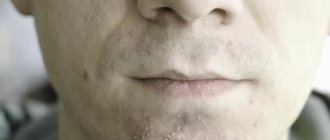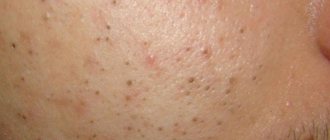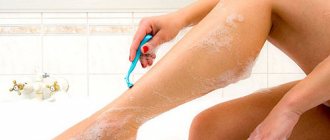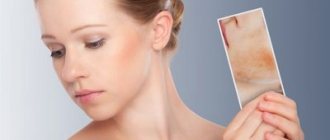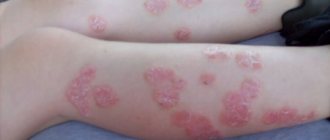How to properly remove blackheads after hair removal – Acne site
The female body reacts differently to stimuli.
In some cases, even carrying out standard and seemingly familiar procedures can result in unexpected negative consequences. For example, blackheads after shaving your legs, armpits or pubic area immediately cause panic. This is a completely natural phenomenon, so there is no need to worry about it.
Simply determine the cause of their appearance and quickly eliminate it using useful recommendations.
What usually causes blackheads to appear after shaving?
Hair removal is, one way or another, damage to the skin. After shaving, the pore through which hair penetrates narrows. If you use modern razors that eradicate hairs, there is a chance that the new growth simply will not be able to break through the narrowed channel. It is this process that causes the formation of a blackhead.
You need to understand that in this case there are no similarities with comedones that form on the face, shoulders, back and stomach. When a blackhead appears, the black color is caused by a plug of dust, sebum and dead skin cells of the epidermis. In blackheads after shaving, you can see the hair itself on the outside. Its diameter practically coincides with the pore. This is where the resemblance to comedones comes from.
This process does not pose any serious danger; however, the fact that the hair cannot come out is an abnormal situation. Therefore, you need to find effective ways to free up the pores. It is recommended not to use this shaving method anymore or to go through the shaving procedure more slowly.
How to avoid blackheads after hair removal
Study the suggested recommendations so as not to encounter such a problem in the future. This is to maintain the integrity and proper functioning of the skin.
- The right tool is the key to success. Don't spare money on quality depilators. They are expensive not because it is a whim of the manufacturers, but because they actually perform their functions correctly and do not threaten your dermis in any way.
- Take care of your instrument. Even if the depilator is chosen correctly and the first shaving procedures did not lead to negative consequences, blackheads may appear after some time. This means that the tool needs to be updated. Pay special attention to the blades you use. The expiration date is indicated on each package. Follow this recommendation exactly. The biggest mistake is using disposable machines on an ongoing basis. The blades become dull after the first procedure. Next, the device simply cuts off the hair. The formation of black dots in this situation is a regularity.
- Use additional skin care products. If blackheads don't appear after shaving, you may notice hair growing on your skin very quickly. There are a number of special products that slow down hair growth. Use them after first studying the composition and making sure that the chosen preparations are suitable for your skin type. Also, be careful about the selection of products before, during and after shaving. It is advisable to use drugs from the same developer or even from the same line. These options are compatible with each other as much as possible.
- Don't epilate too often. Remember that hair removal is, although minimal, still damage to the skin. Therefore, by frequently shaving your legs, armpits, or bikini area, you are preventing your skin from healing and repairing itself. It is advisable to carry out the procedure no more than twice a week.
How to get rid of blackheads after shaving on legs, bikini area and armpits
These methods are universal. They are often used by different patients, but keep in mind that the chosen product should suit your skin type.
Universal ways to eliminate blackheads after shaving:
- After a shower, treat the affected areas of the skin with scrubs based on apricot kernels. This product gradually destroys the top layer of the epidermis and expands the pores, allowing the hairs to break out. Remember that every scrub is an aggressive substance, so massage your skin with this product for no longer than two minutes.
- Poor hair growth can cause your skin's overall health to deteriorate. Additional inflammation, the appearance of a rash, or even the development of an infectious pathology are possible. Therefore, doctors recommend regularly treating the affected areas with nourishing or moisturizing preparations. This will help strengthen your immune system and speed up hair growth. Accordingly, blackheads will disappear much faster. Of course, additional means should be used for this.
- You need to at least slightly reduce the amount of sebum secreted by the sebaceous glands. This will prevent acne from occurring when the hair cannot pass through its own channel. To do this, you can use medications, cosmetic preparations or homemade products. It is important to understand that such medications are only suitable for oily skin. Dry type requires completely opposite care.
How to take care of your skin so that you don't have blackheads after shaving
First of all, re-examine the hair removal methods you use. If you follow all the recommendations, but black dots still appear after each procedure, it is better to have hair removal in a salon. This will give a much better effect, while the end result will look much better. The skin remains smooth and pleasant to the touch for a long time.
Popular hair removal procedures:
- Laser hair removal. A hardware method in which the patient does not experience any discomfort. There is no physical contact with the skin, but the laser is as effective as other methods.
- Electrolysis. Electrical impulses are sent to the skin, causing the hair to simply fall out.
- Photoepilation. The device applies light rays to the skin. Melanin absorbs them and transmits the impulses further. The hair, as in the previous case, falls off.
Ingrown hairs can be removed if gentle treatments do not help you. But this is an important procedure, so pay attention to it so as not to get negative consequences. Watch the video below for details:
Blackheads after shaving have nothing to do with the functioning of the sebaceous glands or clogged pores. These are ingrown hairs that need to be treated in a completely different way.
Source: //pryshhikov.ru/dermatologiy/chernye-tochki-posle-epilyacii.html
How to get rid of blackheads after hair removal?
Blackheads that appear on the legs after hair removal are essentially hairs that have grown into the skin. They remain both after shaving and after using an electric depilator, special cream or wax.
There are several different methods you can use to remove blackheads on your calves and the areas above your feet.
Why do blackheads appear after hair removal?
Epilation involves removing only the cutaneous part of the hair, leaving the hair follicle intact. After several exposures, the skin becomes rough and the hairs become weak. All this disrupts the processes of natural hair growth. They begin to grow into the thickness of the skin, so black dots form on the legs and itchy skin appears.
If you scratch the skin on your legs and feet, various microorganisms penetrate inside. As a result, pimples or ulcers form. After healing of the wound remaining at the site of severe suppuration, an ugly pigmented spot sometimes appears.
Please note: do not squeeze out pustules and blackheads on your legs with your hands, as this causes increased inflammation. The process spreads to other areas of the skin.
How to remove blackheads on legs?
In order to remove black dots that appear after hair removal, you need to remove ingrown hairs. Women with thin skin can use a hard scrub. It exfoliates the top layer of the epidermis and the hair grows normally.
Another simple way to extract hairs at home is to use tweezers and a thin needle:
- They must first be disinfected by dipping in alcohol. Wash your hands well with soap. Wipe the skin on your legs and feet with an antiseptic
- Carefully insert the needle next to the hair and tear the skin in a reverse motion
- When the hair appears on the surface, pull it out with tweezers. Try to injure your feet as little as possible
- At the end of the procedure, treat the skin with an antiseptic again
Important: Do not remove ingrown hairs using your nails, otherwise you may get an infection. If black spots appear constantly on your calves and in the area above your feet, change the method of removing hair.
Preventing the formation of blackheads
The procedure for removing ingrown hairs on the legs is not accompanied by pain, but it is unpleasant and time-consuming. It is better to try to prevent their occurrence. To this end, follow a few simple rules.
- Steam the skin on your calves and feet a day before hair removal using any method (including shaving). Then treat it with a scrub
- The next day after hair removal, also use a scrub.
- Treat your skin with a scrub once every 1-1.5 weeks
- Before removing ingrown hairs, also try to take a shower and steam your calves and feet. The pores on the skin will expand, the skin will be soft, and the hairs will be flexible.
- When removing hair using an electric epilator, carefully ensure that its blades are clean.
- Use hair removal wax only once
- In some cases it makes sense to wait. The skin and hairs gradually “get used” to hair removal and the black spots will disappear on their own
How to care for the skin of your feet to prevent blackheads from appearing?
To ensure high-quality skin care on your calves and feet, purchase peeling creams that contain fruit acids. They have exfoliating and softening effects. To get rid of ingrown hairs, use the product every other day.
Use a loofah sponge in the shower. It will help cleanse the skin of dead cells. After water procedures, apply nourishing cream to your feet.
Use products that slow down the growth of vegetation. In this case, it will be possible to epilate less often. The result of proper foot care will be the disappearance of ingrown hairs. In addition, they will be thinner.
Epilation of legs in beauty salons
Epilation of legs in a salon is an effective way to remove “vegetation”. The epidermis is not injured as much as after using a depilator or after shaving. Black spots on the legs do not subsequently appear.
Salon methods of hair removal include: photoepilation, ELOS hair removal, hair removal using laser, electricity.
Indications for salon procedures:
- a large amount of vegetation or too dark hair color
- sensitive skin
- irritation after hair removal by shaving or depilatory
- formation of black dots
Contraindications to hair removal in salons:
- numerous moles, age spots
- skin injuries
- oncological diseases
- varicose veins
- diabetes
- exacerbation of allergies
- infections
Electrolysis
Electrolysis is used to remove hairs that grow quite rarely. During the procedure, an electrical impulse passing through the hair shaft destroys the follicle (bulb). As a result, hair does not grow.
Photoepilation
The principle of photoepilation is based on the ability of melanin, located in the hair shaft, to absorb light radiation. The photoepilator creates high-frequency light flashes of high intensity. This causes heating and destruction of the hair follicle.
After a few days after the procedure, the hairs fall out on their own. On surfaces treated with a photoepilator, “vegetation” will not appear for 8-10 years. To completely get rid of hair on your legs, you will need 3-8 sessions.
ELOS hair removal
ELOS hair removal is a fairly new method of removing “vegetation”. The necessary effect is provided by 2 active factors - high-frequency light radiation and electric current. The procedures slow down the growth of hair, which becomes thinner.
This type of hair removal does not lead to overheating of the skin. This minimizes redness and irritation of the epidermis. Most often, 4-6 sessions are needed.
Laser hair removal
Laser hair removal is great for hair removal, but this procedure is quite expensive. After the 1st session, new hair appears after 3-5 weeks, but it becomes 10-20% smaller. To get rid of hairs, you will need a course consisting of 4-5 sessions. Then you will need to come for maintenance sessions every six months to a year.
You need to prepare for hair removal using a laser. A prerequisite is that the hairs must be 3-4 mm long. For 10-14 days before and after hair removal, you should not visit the solarium or sunbathe.
Skin care after laser hair removal
Laser skin treatment is a somewhat traumatic procedure. In order for the skin to recover as quickly as possible, in the next 3 days after the session, apply the external preparation “Panthenol” (cream or aerosol) to the skin morning and evening. It is sold at the pharmacy.
To avoid skin irritation, refrain from visiting the sauna, bathhouse, or swimming pool for 3 days. Take a bath or shower in moderately warm water. These tips will help you get rid of hair and blackheads on your legs.
Source: //prisch.ru/chernye-tochki-posle-epilyacii/
Indications and contraindications for salon procedures
Before you begin salon procedures, you should familiarize yourself with the main indications and contraindications for their implementation. Without exception, all hardware methods are safe, but without taking into account some nuances, unwanted complications may arise.
Indications for procedures:
- excessive vegetation and its dark color,
- tendency to ingrown hairs and the formation of blackheads,
- increased skin sensitivity and irritation after home procedures - shaving and hair removal.
- presence of cancer,
- an abundance of nevi and age spots,
- injuries, cuts and abrasions on the skin,
- exacerbation of allergic diseases,
- diabetes,
- phlebeurysm,
- infectious diseases,
- heart pacemakers,
- hormonal imbalance.
READ ALSO: Review of Lipoma Removal | It was as if nothing had happened!
Unfortunately, the main disadvantage of all procedures is their cost. For many, this factor is a stumbling block to their implementation. It is worth paying attention to all kinds of promotions offered by salons. For example, many offer 5 procedures for the price of 4, or you can remove hair on your legs and get armpit hair removal as a gift. So the choice is yours!
If hairs on your legs grow in after hair removal, you definitely need to fight them. It is very important to do this correctly, without neglecting the basic rules of asepsis and antiseptics.
You can get rid of ingrown hairs yourself if they are located shallow under the skin. But if the hairs have grown into the deeper layers, it is better to consult a doctor - a dermatologist or cosmetologist.
How to fix
It is not at all difficult to independently remove hairs located in the superficial layers of the epidermis. Moreover, it is quite comfortable to do it on your feet.
- A sharp, sterile needle (for example, from a syringe),
- Antiseptic - alcohol-free (chlorhexidine, miramistin) or any alcohol-containing one,
- Cotton pads or gauze wipes (it is better to purchase special sterile wipes already soaked in an alcohol-containing solution).
Black dots on legs after shaving: causes, elimination
Hair removal is a procedure that many people perform for aesthetic purposes. But the result may not meet the requirements, because the manipulation can leave black dots on the skin, which significantly spoil its appearance. When black spots remain after shaving your legs, it is important to know how to overcome the phenomenon, and whether they can pose a danger.
Causes of black spots on legs
Black spots on legs after hair removal; depilation is almost always safe. They arise for the following reasons:
- When shaving, you cut the hair at the root, flush with the skin. If a low-quality/dull/rusty razor was used, then the cut is of poor quality, the hair protrudes slightly above the skin. For this reason, it is visible as a black dot. When depilating with cream, the chemical composition penetrates the hair canal, dissolving its contents, so there is no such phenomenon;
- When epilating, hairs may be cut off by the device instead of being pulled out if the length is insufficient/excessive/the epilator is of poor quality. Then the same situation occurs as with the razor. Hair removal also causes ingrowths to appear.
Although blackheads are safe, they can make the hair removal result less quality and aesthetically pleasing. Therefore, it is better to try to defeat the phenomenon.
Ingrown hairs after hair removal
If black spots remain after shaving your legs, then they never pose any danger. But epilation can lead to ingrowth. When a hair is pulled out by its roots, its channel narrows, and the lumen of the pore from which it grew is significantly reduced. The hair cannot come out freely through the gap, changes the direction of growth, and grows under the soft tissue.
Such hairs have to be removed manually, pulling them out from under the skin, using tweezers or needles. A complex, unpleasant process that requires great care.
But it is not of a regular, systemic nature, that is, such points appear singly, periodically, irregularly.
With regular formation, the number increases from time to time, it is better to refuse to remove hair from the root, since the number of ingrowths will only increase.
Pathologies
In rare cases, blackheads resulting from the use of an epilator, sugaring, or wax can provoke the development of pathology. We are talking about situations where ingrowth develops over a long period of time. Hair can grow in for quite a long time; its subcutaneous part can be several millimeters.
The epidermis is constantly injured. Over time, inflammation occurs around the black point of ingrowth, which develops when an infection enters a microtrauma. Inflammation increases, suppuration appears, the inflammatory process can spread actively, occupying large areas. Rarely, but a massive inflammatory process can develop. Therefore, ingrowths must be treated promptly.
How to get rid of blackheads on legs?
How to get rid of blackheads after shaving or hair removal? The most appropriate method is determined by the reasons for which they arose.
Scrubs
If some black spots remain after depilation with cream, then a scrub can help.
The phenomenon occurs when the cream, although it penetrated into the canal, but the dissolved hair remained unremoved when the cream was removed. It is he who colors the pore.
It is necessary to use a scrub to expand the hair canal so that the remaining hair can leave it. However, if the unpleasant phenomenon is caused by shaving, this renders the scrub useless.
For skin that has undergone epilation, using a scrub is very useful, but only after 48 hours after the procedure, to give the skin enough time to recover on its own and heal.
It also needs to be used 24 hours before. The scrub will expand the pores of the hair canals so that the hairs come out of them freely, without ingrown hairs.
Regular scrubbing of areas where stubble is removed from the root helps reduce the number of ingrown hairs.
Antiseptics
Antiseptics by themselves are powerless to solve the problem of cutaneous blackheads. However, they can prevent the development of serious complications. Treating skin that has undergone epilation with non-alcoholic antiseptics (Chlorhexidine, Miramistin) reduces the likelihood of developing an inflammatory process in the ingrown area. Hair can be easily removed.
Ointments
Medicinal ointments and anti-inflammatory compounds are indicated when the points that appear as a result of ingrowth cause inflammation. Redness and local swelling appear around each of them. The following compositions are indicated for use:
- Panthenol;
- D-Panthenol;
- Bepanten.
You need to lubricate the inflamed areas of cleansed skin three times a day with the ointment. Also use a non-alcohol antiseptic between applications. Carry out this treatment until the pathological symptoms disappear completely.
Solving the problem using folk remedies
A complete solution to the problem cannot be achieved using folk remedies. However, there are several ways that can reduce the likelihood of its occurrence:
- Use coffee grounds as a scrub - save them after brewing coffee, treat the epidermis in the standard way;
- Use baby cream as a care product.
These methods will improve your skin condition.
How to prevent the problem from recurring?
Recurrence of the problem can be avoided by following these recommendations:
- When shaving, use only sharp, new razors;
- When using the cream, apply a scrub regularly;
- When removing stubble from the roots, use a special hair removal product against the formation of ingrown hairs, and use a scrub regularly.
Such measures will prevent the problem from recurring.
Conclusion
Black spots on the legs after hair removal are most often completely safe, the skin feels completely healthy, and there are no unpleasant sensations. However, it should be disposed of to avoid the development of potential complications.
Source: //zhenskiy.guru/volosy/udalenie-volos/depilyatsiya/brite/chernyie-tochki-na-nogah-posle-britya.html
Complications
Meanwhile, if you discover a wart on the skin, you should not wait for it to disappear, but it is better to immediately begin treatment so that the disease does not spread from the legs to other parts of the body. Lack of treatment can lead to infection of surrounding people with the papilloma virus, while treating warts after a while will be problematic and time-consuming.
Infection with the virus can occur through direct contact with the skin of the source, so it is important to exercise extreme caution and practice good personal hygiene to prevent the virus from spreading to healthy people.
The human papillomavirus is dangerous because it can live freely without human intervention for several months, so it can settle on the walls of showers, benches, floors and remain there for a long time until the room is thermally treated.
In this regard, the virus is aggressive and contagious; it attacks the human skin as a result of direct contact and enters the body through the outer layers of skin cells. After the virus enters the body, a person may not be aware of its presence for a long time, since the disease, as a rule, does not manifest itself for several months.
If foot warts are not treated promptly, they can cause significant pain. In addition, plantar warts can actively grow through autoinoculation and infect healthy skin on the foot in the area of the tumor. Similarly, small warts on the foot can connect with each other and form large clusters like a mosaic.
Plantar warts look very unpleasant and are accompanied by features that cause discomfort, and the structure of the wart in this case is no different from what is found in other parts of the body.
The appearance of hard and rough growths on the soles of the feet, causing significant discomfort; Constant itching on the soles of the feet; Pain of varying degrees of intensity while walking and running; When pressing on the tumor, noticeable pain is felt; In some cases, warts may bleed when injured or deliberately cut.
New growths on the soles have an unpleasant odor and are yellowish or dirty brown in color. If a wart on the foot is opened, inside you can see numerous black dots formed due to damage to the capillaries, which often bleed. It is the presence of such points that distinguishes a plantar wart from other types of injury to the skin of the feet.
Black spots on legs after hair removal - treatment
After depilation and some hair removal techniques, many women notice the appearance of black dots on the skin of their legs. Such a problem can bring considerable discomfort, and therefore requires a high-quality solution. What causes black spots to appear on the legs and how to eliminate them remains to be discussed in more detail.
Causes and mechanisms
Depilation involves removing only the outer part of the hair, leaving the root intact. If the rod is dark in color, it will still be slightly noticeable against the background of light skin. This is a common condition accompanying depilation. There may be another situation, for example, when the hair bends and re-embeds its tip into the skin, forming a kind of loop.
Dark spots that appear after hair removal often indicate ingrown hairs. A root that has been destroyed will still regenerate over time, but the direction of the rod may change (not upward, but sideways). Violation of natural hair growth certainly requires further correction.
If the epithelium is thick enough, then even normal hair will have difficulty breaking through it after epilation. This creates conditions under which an inflammatory process occurs.
While it is aseptic in nature, the addition of microbial flora (for example, when scratching) can cause pustules.
Then the black dots become covered with pustules, turning from spots into tubercles filled with yellow exudate.
The cause of black spots on the legs is the consequences of hair removal - improper growth, bending, inflammation.
Remedies
Every woman, faced with the problem in question, wants to understand how to get rid of blackheads. This is quite easy to do - everything can be done at home. If the skin is thin, then you can remove ingrown hairs using a hard scrub (coffee, with apricot kernels), which exfoliates the surface layer of the epidermis.
When the method described above does not help, you can remove blackheads on your legs in another way - using a needle and tweezers. This is generally done when there are a small number of ingrown hairs. The sequence of actions is as follows:
- Wash your hands with soap.
- Treat the skin and instruments with an antiseptic (ethyl alcohol).
- Carefully insert the tip of the needle next to the hair, making a small tear.
- Using tweezers, pull the hair out.
- Treat again with an antiseptic solution.
It is not recommended to remove hairs with your fingernails, as this may cause infection in the skin. And it should be remembered that all activities must be carried out carefully, without causing severe injury to the epithelium. Sometimes it is recommended to wait a while for the hair to get used to hair removal - then it will grow in the right direction and the dark spots will disappear.
Removing blackheads at home is not at all difficult - for this you use a hard scrub or instrumental removal (with a needle and tweezers).
Diagnostics
Often, in appearance, warts on the foot resemble ordinary calluses on the feet, but it is possible to distinguish a wart from a callus based on some signs. Firstly, a wart most often does not hurt; painful sensations begin only after a while, when the tumor begins to grow.
There is no fluid inside warts, unlike calluses. In addition, black dots form in the wart, which appear due to blockage of the smallest blood vessels inside the body of the wart.
Very often, a wart on the foot appears flat and pressed into the sole of the sole; this occurs due to the regular pressure placed on the wart by human weight while walking or running. At the same time, the tumor grows from the inside, and new skin growths appear on the wart. In this regard, the information in the article Warts on the legs: treatment and prevention will be interesting.
Thus, diagnosing a wart on the body is quite simple and almost anyone can do it. If such a viral disease is detected, long and difficult treatment awaits. However, there are cases when warts on the foot can disappear after a while on their own, without medical intervention. According to statistics, in 27 percent of cases, complete recovery from warts on the soles occurs within four to five months.
